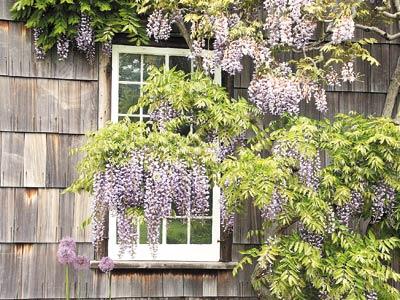Romanticism vs. Reality

Wisteria in flower evokes the most romantic garden fantasies. Monet planted it famously above a Japanese bridge in his water garden at Giverny, and of course painted it.
You have to read the fine print to discover that while the vines he planted are still thriving, they literally tore down their supports. The reality is wisteria is high maintenance, very high maintenance, and 99.5 percent of us don’t have the know-how or resources to keep it under control and flowering, say, as in a Monet painting.
Even Mike Dirr, the dean of woody plants in America, who may never have seen a tree or shrub he didn’t love, said wisteria can be a pernicious pest, strangling everything in its grasp. “Must be used with a certain amount of discretion and a commitment to proper culture and pruning,” is his restrained advice.
The south-facing facade of Home, Sweet Home in East Hampton is covered with a beautifully trained wisteria that was reblooming at the end of July. Hugh King, the director of Home, Sweet Home, recalled that one year when the vines were not pruned, flowering was seriously compromised.
Longwood Gardens in Pennsylvania has a famous wisteria collection and I asked Mark Mosinski, the gardener responsible for it, for tips.
First and foremost, when purchasing a vine, try to get it in flower. The rule of thumb is to purchase wisteria from a reputable source, but even that is not enough. The late Sir Peter Smithers, a great gardener, grew a collection of more than 20 different wisterias along the railing of the veranda that surrounded his house in Switzerland. He tells the story in his memoir of purchasing Black Dragon (very deep purple) from one of the foremost nurseries of his day. It took four years for the vine to reach the railing and another year for it to spread across the railing until it finally flowered — white! The steam still rises off the page of the letter of complaint the retired diplomat sent to the nursery owner.
Interestingly, wisteria does not begin to flower profusely until it has expanded to the space allotted to it.
Second, Mark Mosinski told me, to flower well wisteria requires full sun. So don’t kid yourself into thinking five or six hours a day is enough. If you don’t have full sun, select another vine, Clematis montana for instance, that isn’t so particular.
If your wisteria does not flower and definitely is pruned properly and has full sun, there are other possibilities: Perhaps it was raised from seed, which invariably makes an inferior plant, or was grafted onto a seedling and the graft died, leaving the seedling as the vine. Mr. Mosinski doesn’t give much credence to suggestions that root pruning or tightening a wire around the vine to make it think it is being killed will promote flowering.
At Longwood wisteria is pruned throughout the growing season to maintain its shape by removing the long shoots. In late winter, just before the buds begin to swell, the Longwood gardeners do their structural pruning, removing most of the previous season’s new growth. They even cut back spurs, or side shoots that have flowered, to three or four buds. Flower buds are thinned out so the racemes of flowers fall more freely for a better display.
Bringing a vine back to good condition and beauty after it has been neglected is situation-specific, Mr. Mosinski said. In some cases if the trunks are thick and appear to be dying, cut them back to the ground and train a few suckers as replacements. You might be able to remove some of the largest trunks and train younger branches. (The rule of thumb in pruning shrubs is to remove one-third of the oldest branches to the ground every year; modify this for an overgrown wisteria.) Prune so the vine looks like it hasn’t been pruned, he suggested.
“Wisteria is a lot of work,” commented Mr. Mosinski. Removing suckers and runners are a constant project. Neglecting this is done at your peril: Runners have scaled a wall more than 50 feet away from a vine in East Hampton Village and new vines have quietly begun their own travels.
The two American species of wisteria are less aggressive and thuggish than the Japanese and Chinese species, although Dr. Dirr said Wisteria frutescens is vigorous. W. frutescens Amethyst Falls was honored with the Pennsylvania Horticultural Society’s Gold Medal Award and has been popular at the garden club plant sale in recent years. Next year, I hope, we will have the Kentucky wisteria, W. macrostachys Clara Mack, which has fragrant white flowers in long racemes.
Stories of wisteria bringing down stout wooden pergolas and arbors, not to mention towering trees, and my friend’s deck, are legion.
If your romantic garden fantasies will be satisfied only by rows of fragrant, long racemes of wisteria dangling overhead, at least let the realist insist on a steel support.
